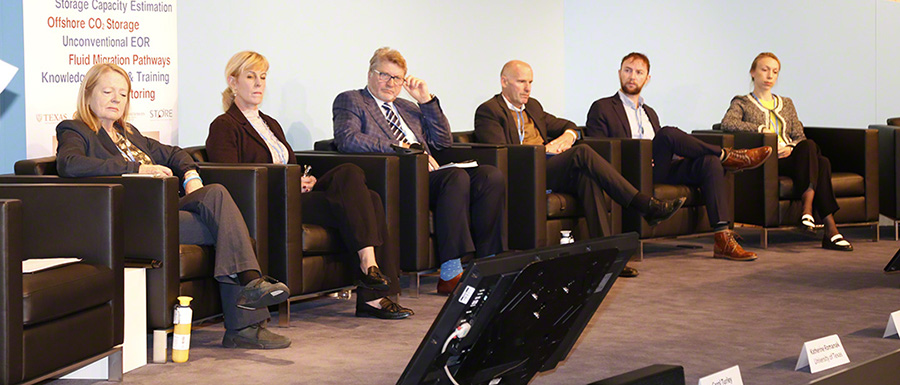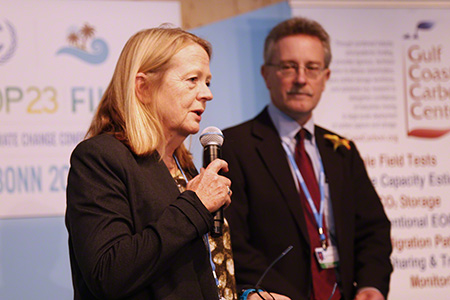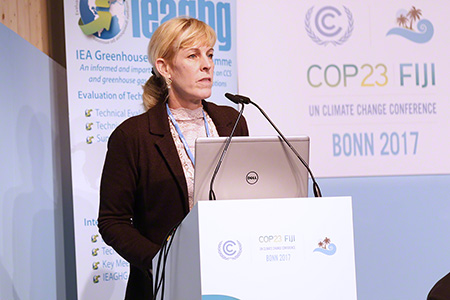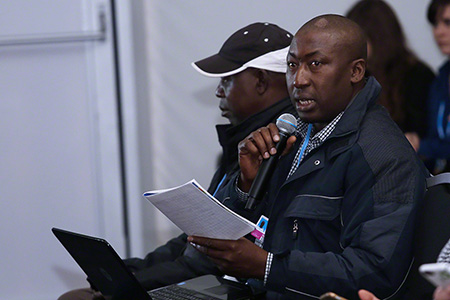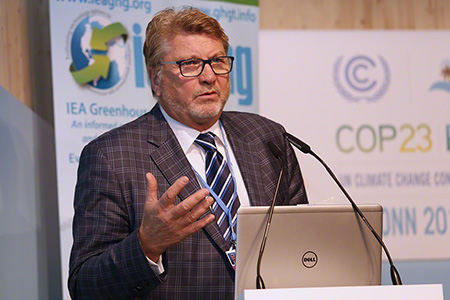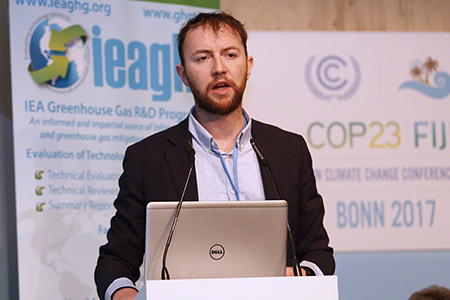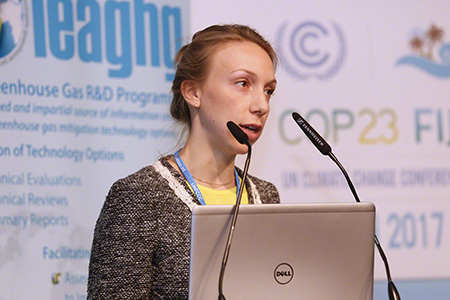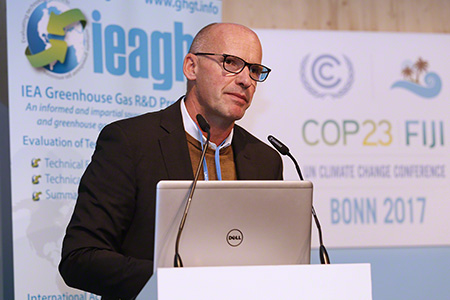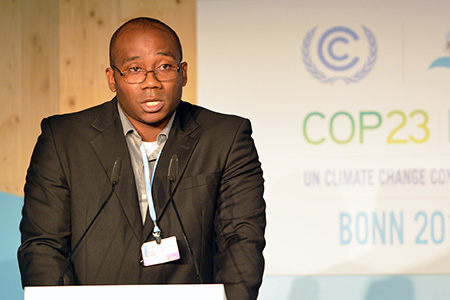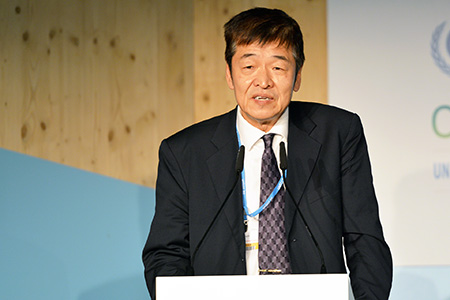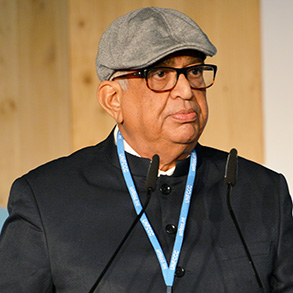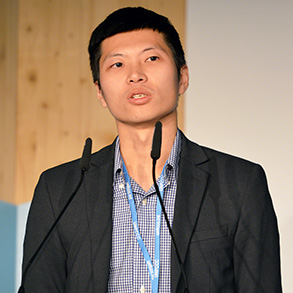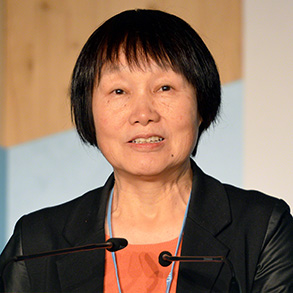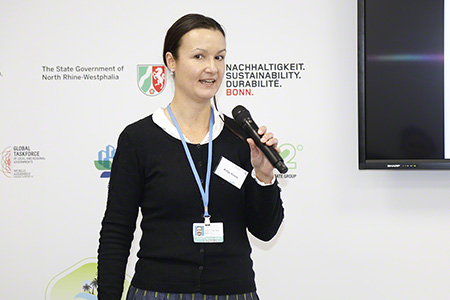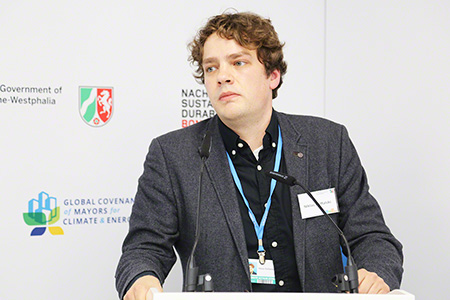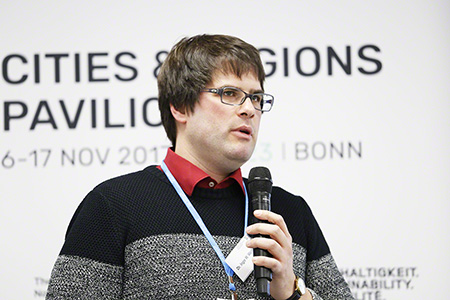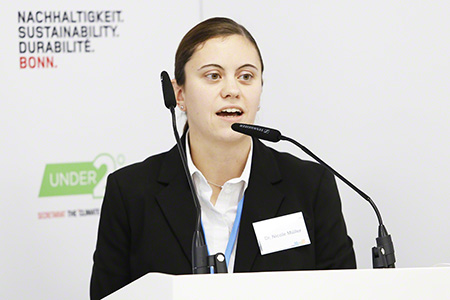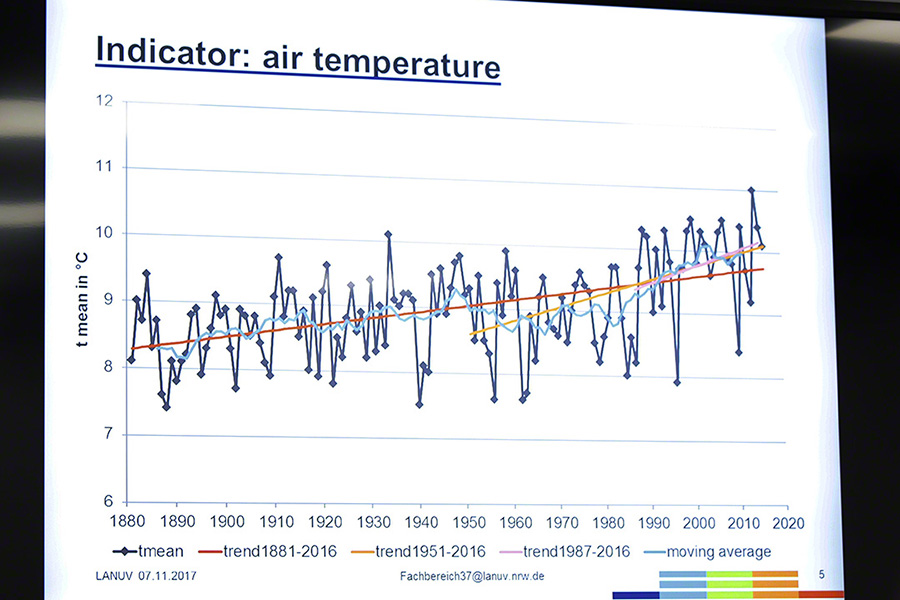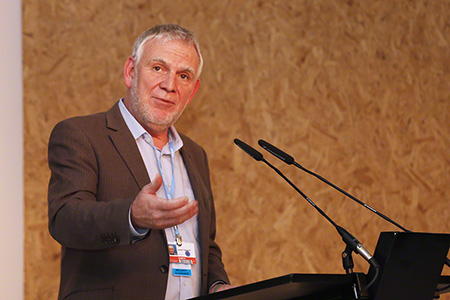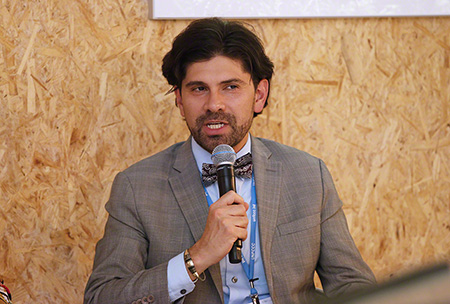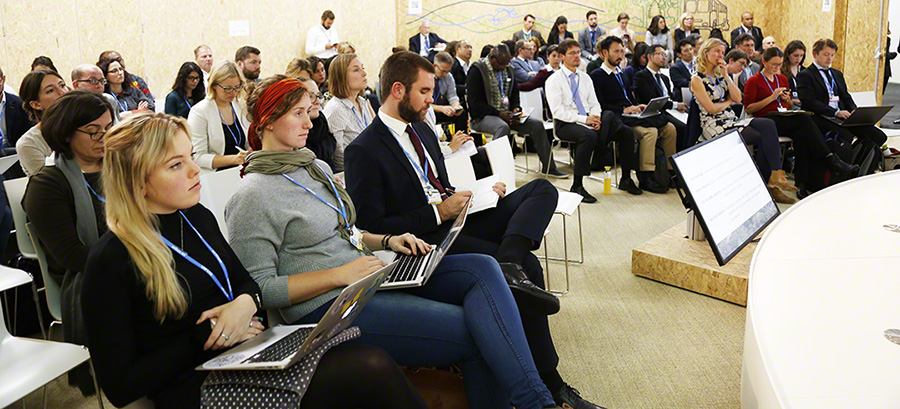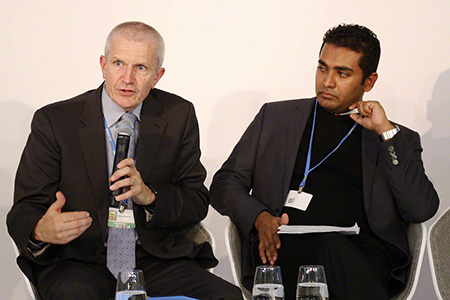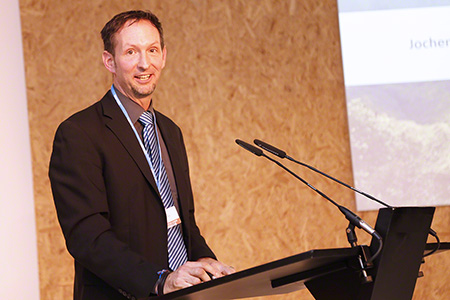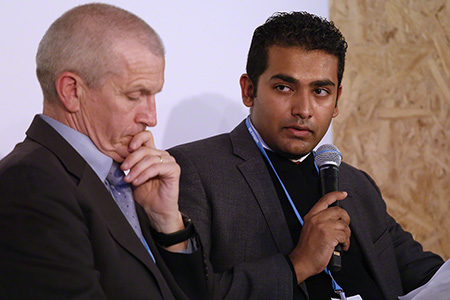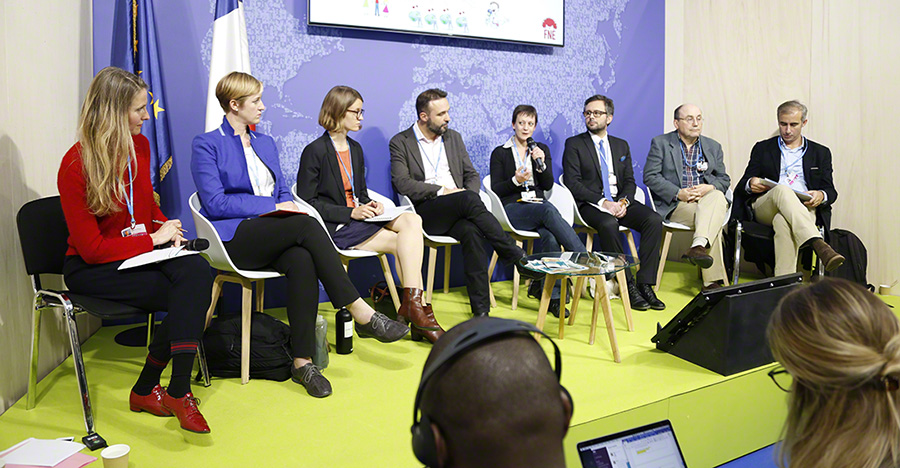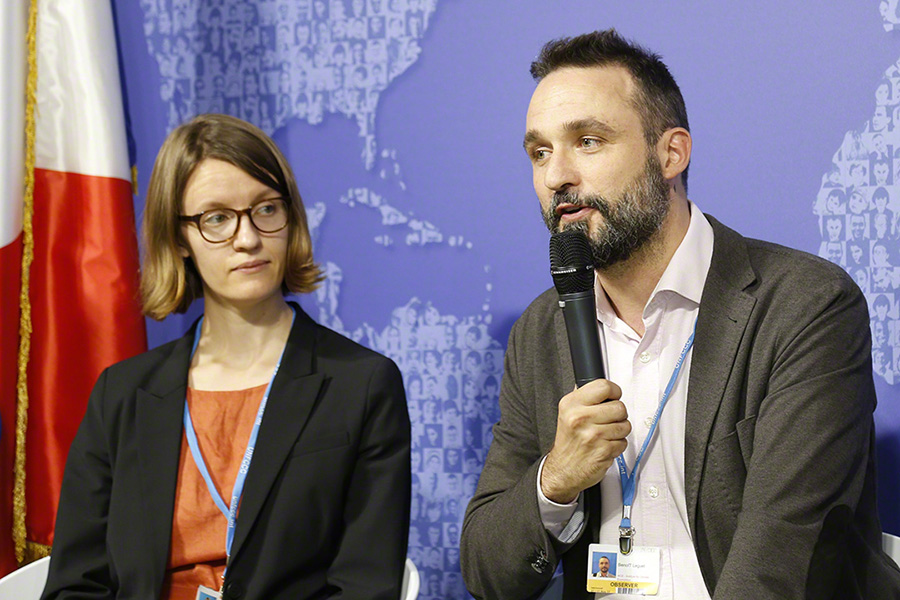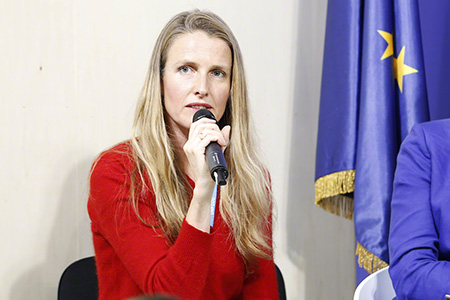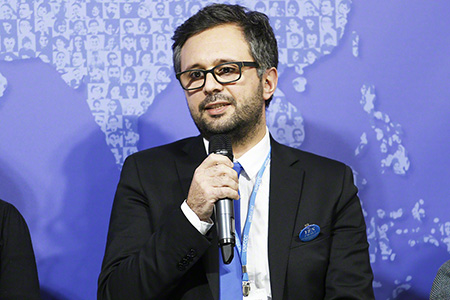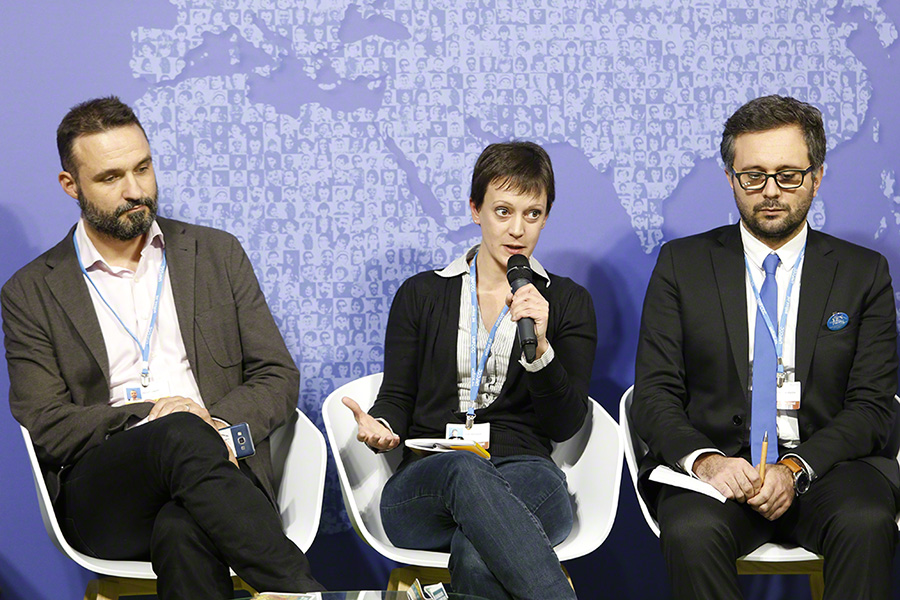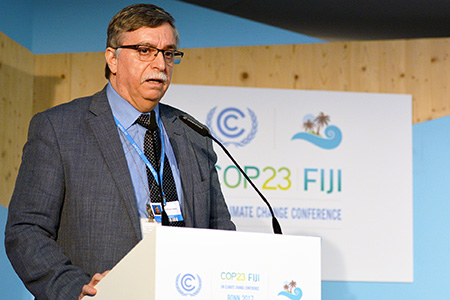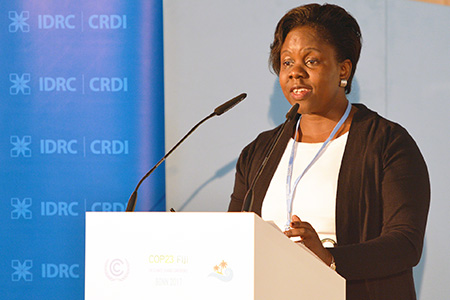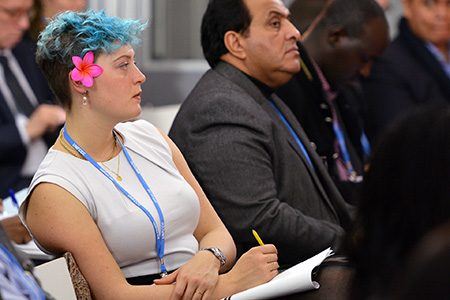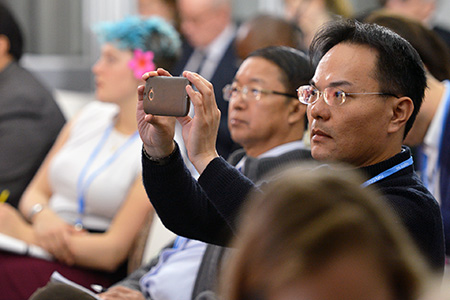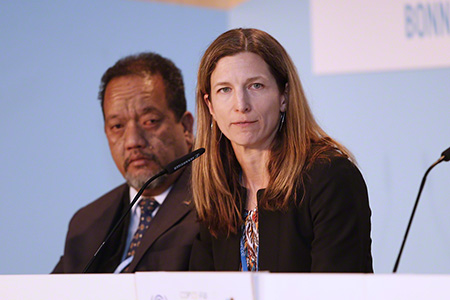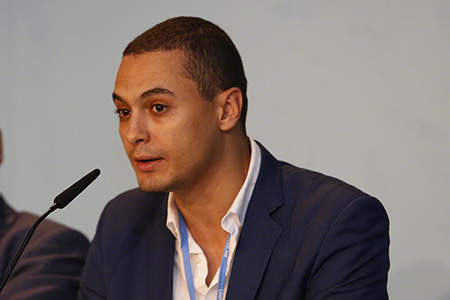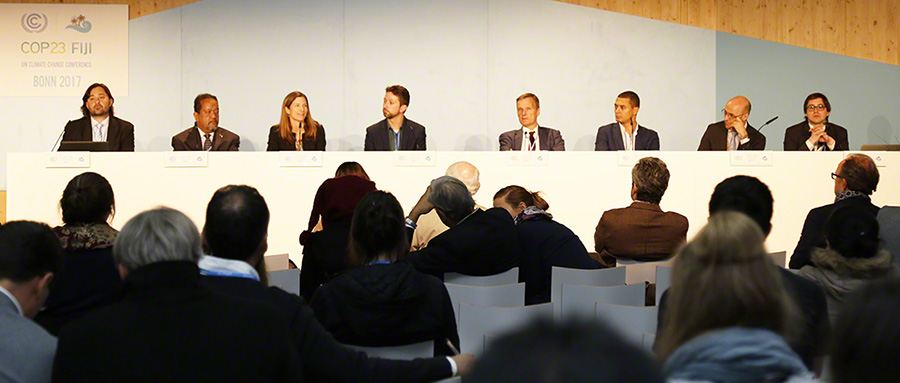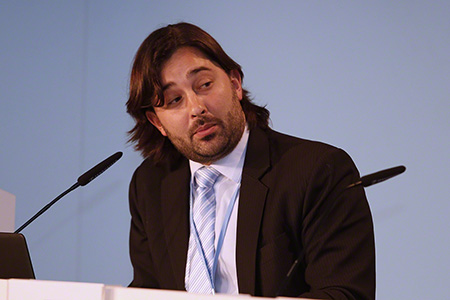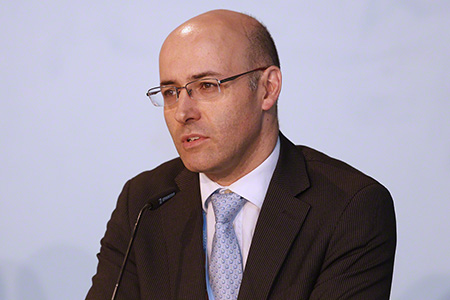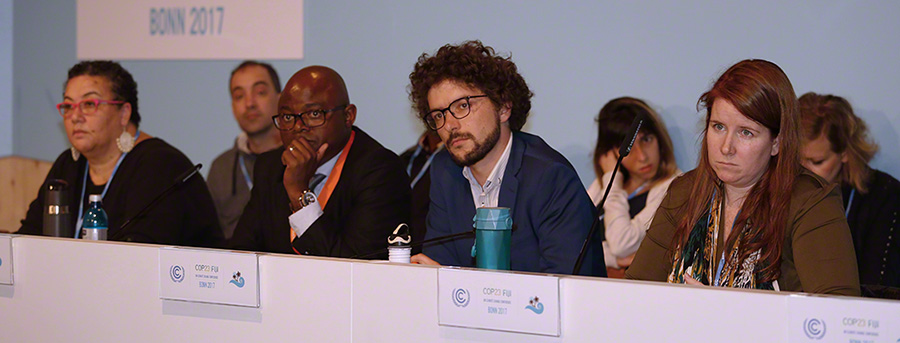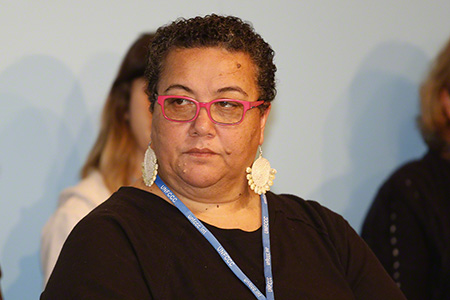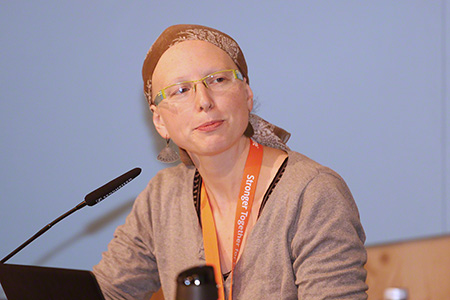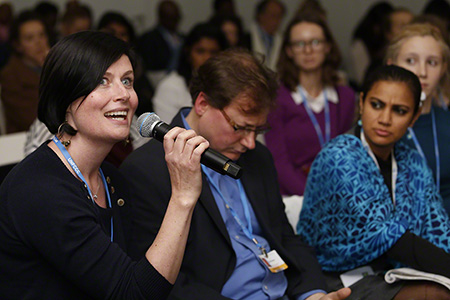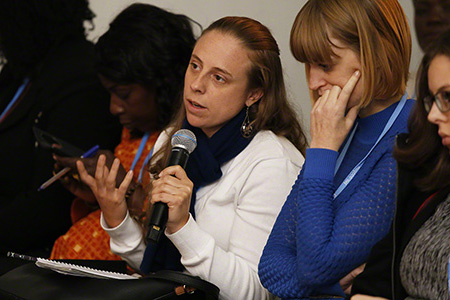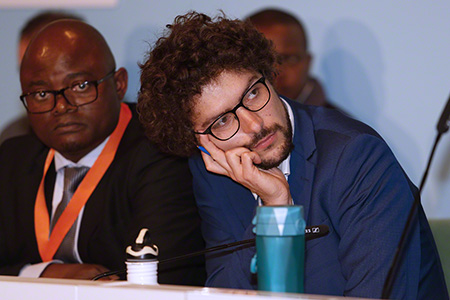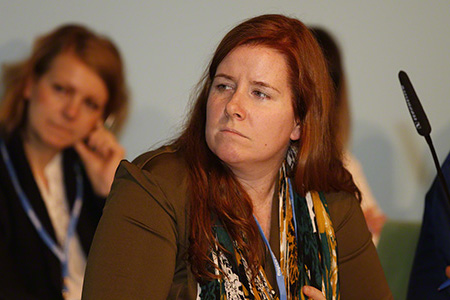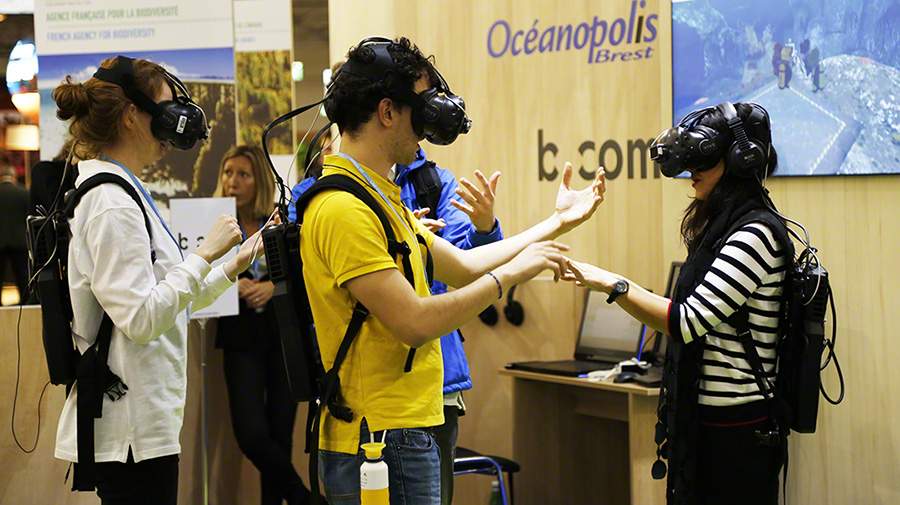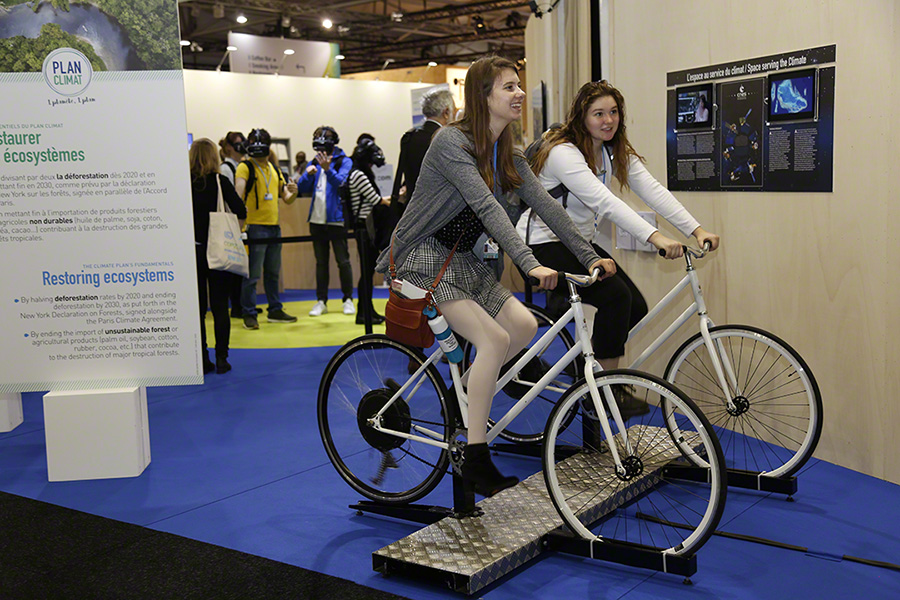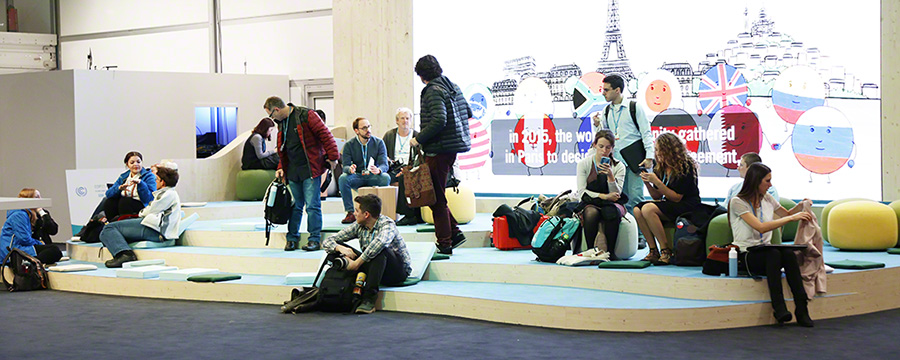Summary

The following events were covered by IISD Reporting Services on Tuesday, 7 November 2017:
- Carbon Capture and Storage (CCS) Developments Towards a 1.5 World: Will They Help the Oceans and Small Island Developing States?
- Building Capacity of Tackling Regional Climate and Sustainable Challenges
- Climate Change in North Rhein-Westphalia, Germany: Monitoring and Adaptation Strategies
- The Global Platform for the New York Declaration on Forests and the Bonn Challenge: From Commitments to Action
- Sustainable Forest Management and Climate
- Measuring Progress on Climate Adaptation and Resilience: From Concepts to Practical Applications
- Enhancement Options, Participatory Processes, and Rapid Implementation of Nationally Determined Contributions (NDCs)
- Guaranteeing Rights and Gender Equality in all Climate Action: Prerequisite for Sustainable and Fair Action
IISD Reporting Services, through its Earth Negotiations Bulletin on the Side (ENBOTS) Meeting Coverage, will provide daily web coverage from selected side events at the UN Climate Change Conference - November 2017.
Photos by IISD/ENB | Ángeles Estrada and Herman Njoroge Chege
For photo reprint permissions, please follow instructions at our Attribution Regulations for Meeting Photo Usage Page.
Carbon Capture and Storage (CCS) Developments Towards a 1.5 World:
Will They Help the Oceans and Small Island Developing States?Presented by the IEA Greenhouse Gas R&D Programme (IEAGHG), University of Texas at Austin, Bellona Foundation,
and Carbon Capture and Storage Association
This session, moderated by Tim Dixon, IEAGHG, explored carbon capture and storage (CCS) and its relationship to small island developing states (SIDS).
Carol Turley, Plymouth Marine Laboratory (PML), presented on ocean acidification and the need to reduce CO2 emissions. She explained that CO2 reacts with water to cause ocean acidification, which is highly corrosive to marine life, including reefs and mollusks.
Dixon outlined the London Convention’s response to the impact of CO2 in the atmosphere, including its conclusions on low carbon technology and CCS.
David Alexander, University of Trinidad and Tobago, via Skype, highlighted the devastating impacts of natural disasters on the Caribbean. He noted that Trinidad and Tobago has the second highest greenhouse gas (GHG) emissions per capita globally, but that results from a CCS simulation in a local BP reservoir were promising.
Katherine Romanak, University of Texas at Austin, shared her experience studying CCS, stating that offshore CCS has the potential to store gigatons of CO2. She suggested that CCS was advantageous to SIDS, as results from monitoring provide additional findings on the marine environment.
Mike Monea, International CCS Knowledge Centre, explained that his organization constructed facilities to capture emissions from power plants and convert CO2 into other products.
Geir Lippestad, City of Oslo, Norway, shared his city’s experience with CCS, stating that plans to build a CCS facility at the Klemetsrud waste incineration plant would reduce emissions significantly. He underscored that this effort was critical to reaching the target of zero emissions by 2050.
Keith Whiriskey, Bellona, explained that industry contributes a substantial amount of GHG emissions, but that its products are necessary. He posited that CCS is a good alternative to carbon pricing, which hurts industry due to uncertainty.
Clara Heuberger, Imperial College London, stated that CCS power plants are key to supporting upcoming power systems. She added that CCS removes CO2 from the atmosphere and provides ancillary services.
Dixon concluded the session, reiterating the negative effects of CO2 on oceans, and stating that CCS is a solution available now.
L - R: Carol Turley, PML; Katherine Romanak, University of Texas at Austin; Mike Monea, International CCS Knowledge Centre; Geir Lippestad, City of Oslo, Norway; Keith Whiriskey, Bellona; and Clara Heuberger, Imperial College London
Carol Turley, PML, said that “current Nationally Determined Contributions (NDCs)
are not enough to stop ocean acidification,” which causes the dissolution of unprotected shells.
Tim Dixon, IEAGHG, stressed that climate change is a “key issue for intergenerational equity.”
Katherine Romanak, University of Texas at Austin, declared: “CCS works, and we know how to show that it works.”
A participant poses a question to panelists.
Mike Monea, International CCS Knowledge Centre, said his organization teaches governments about regulation and policy, which is necessary before beginning CCS projects.
Keith Whiriskey, Bellona, said that “we now have a way of stopping CO2 from going into the atmosphere.
Clara Heuberger, Imperial College London, said that CCS is the lowest cost solution to decarbonization.
Geir Lippestad, City of Oslo, Norway, stated that, if realized, CCS in his country would reduce emissions by 400,000 tonnes a year.
Contact:
-
Tim Dixon (IEAGHG) | tim.dixon@ieaghg.org
Katherine Romanak (University of Texas at Austin) | katherine.romanak@beg.utexas.edu
More Information:
Building Capacity of Tackling Regional Climate and Sustainable ChallengesPresented by Belize, the Environmental Quality Protection Foundation (EQPF) and the National Council for Climate Change, Sustainable Development and Public Leadership (NCCSD)
This event, moderated by Lennox Gladden, Belize, highlighted multi-stakeholder approaches to implement climate action, looking at case studies from India, Taiwan and Belize on best practices, risks and lessons learned.
Kirit Shelat, NCCSD, underscored the importance of supporting farmers, particularly women and rural youth, to build climate-smart agriculture through, among other things, comprehensive research based on local agricultural practices. He said that to overcome barriers and build bridges for new partnerships, international cooperation and knowledge transfer are needed.
Szu-Chi Kao, EQPF, presented initiatives by his organization on climate change education in Taiwan, including a child author contest, two books, a course on regional climate change and an online climate education platform: the Taiwan Environmental Education Dialogue.
Ho-Ching Lee, National Central University, gave an overview of research activities through the Taiwan Climate Change Adaptation Technology project, and presented a case study on building capacity for adapting to climate hazards focused on self-governed communities in Tanina, Taiwan. She showed a disaster map created by her team for each case study community, including evacuation routes.
Young Ku, CEO, Taiwan Institute for Sustainable Energy, discussed an approach to measure, report and verify (MRV) GHG emissions. He noted how, historically, data has been poor quality, with gaps and inconsistencies, but since the Paris Agreement, providing reliable data for activities is required. He listed multiple challenges in MRV, including integration across sectors, continuity over time and maintaining innovation, but stressed that tracking progress is critical to achieving the climate goals.
Hsiao-Kang Ma, Taiwan Carbon Capture Storage and Utilization Association, stressed that indicators to measure GHG emission reductions need to be improved. He described the implementation of SDG 7 (affordable and clean energy) in Taiwan and Belize, noting their similarities and potential areas for improvement, as well as a partnership to enhance cooperation, expand infrastructure and develop renewable energy technology.
Jayprakash Gosalia, NCCSD, described a case study of a coastal region in Gujarat, India, which has suffered from ocean water intrusion onto land caused by development in the area. He presented a planning and decision matrix to improve the water quality by developing local resources, including rainwater harvesting, and showed that their work has resulted in increased crop productivity and income.
Rajkumar Korde, NCCSD, talked about climate-smart farming in India by showcasing a technique called “zero-till,” which does not require tillage, flooding or transplantation. It leads to, inter alia, soil enrichment and weed control without generating methane and resulting in a 20-25% increase in output. He emphasized that, with approaches such as this one, it is possible to overcome challenges and convert them into an opportunity to “feed the millions around the world.”
L-R: Kirit Shelat, NCCSD; Hsiao-Kang Ma, Taiwan Carbon Capture Storage and Utilization Association; Young Ku, CEO, Taiwan Institute for Sustainable Energy; Jayprakash Gosalia, NCCSD; Rajkumar Korde, NCCSD; Ho-Ching Lee, National Central University; and Szu-Chi Kao, EQPS
Lennox Gladden, Belize, highlighted the importance of best practices and research to build capacity to address climate change.
Young Ku, CEO, Taiwan Institute for Sustainable Energy, said that one of the main issues faced in capacity building is MRV of GHG emissions.
Kirit Shelat, NCCSD, noted that India has reduced poverty from 90% to 20% since independence, and is working towards a “minimum level.”
Szu-Chi Kao, EQPS, gave an overview of climate education activities in Taiwan.
Ho-Ching Lee, National Central University, said that her research was focused on co-designing, co-producing and co-delivering adaptation solutions with communities.
Contact:
-
Lennox Gladden (Belize) | coord.cc@environment.gov.bz
More Information:
Climate Change in North Rhine-Westphalia (NRW), Germany: Monitoring and Adaptation StrategiesPresented by NRW State Agency for Nature, Environment and Consumer Protection
This session, moderated by Ingo Wolff, NRW State Agency for Nature, Environment and Consumer Protection, centered on climate adaptation strategies at the local level, which are based on a monitoring programme that records climatic changes in NRW. Participants discussed the opportunities for and challenges faced by this region, focusing on the Climate Impact Monitoring 2016 study.
Antje Kruse, NRW State Agency for Nature, Environment and Consumer Protection, explained the work of her organization and noted that it is planning to decarbonize its agency by 2030.
Nicole Müller, NRW State Agency for Nature, Environment and Consumer Protection, presented her organization’s monitoring programme. She explained the programme aims to respond early to climate change, noting the need to prepare for natural disasters, which are increasing across Germany.
Niklas Raffalski, NRW State Agency for Nature, Environment and Consumer Protection, provided a background of the region, which has a population of 18 million people, and has been challenged to deal with heat stress in urban areas. He underscored the goals of the study, including to generate data sets for decision making and to build compensation mechanisms for affected areas. He said that meteorological parameters are set by using a climate simulation model. He noted an output of the study was a classification of the territory into three areas: stress, compensation and cold air corridors.
In the ensuing discussion, participants discussed: inter alia, how authorities received the study; challenges of regional spatial planning in light of climate change threats; how to overcome data gaps and the lack of adaption plans in urban areas; benefits of climate adaption tools for local communities; and threats to the tourism industry.
Antje Kruse, NRW State Agency for Nature, Environment and Consumer Protection, called for concrete indicators and tools to address climate change in cities.
Niklas Raffalski, NRW State Agency for Nature, Environment and Consumer Protection, presented the results of the Climate Impact Monitoring 2016.
Ingo Wolff, NRW State Agency for Nature, Environment and Consumer Protection, invited participants to “actively” engage during the discussions.
Nicole Müller, NRW State Agency for Nature, Environment and Consumer Protection, noted the impacts of climate change on human health.
Contact:
-
Ingo Wolff (NRW State Agency for Nature, Environment and Consumer Protection) | ingo.wolff@lanuv.nrw.de
More Information:
The Global Platform for the New York Declaration on Forests and the Bonn Challenge: From Commitments to ActionPresented by the German Pavilion, the UN Development Programme (UNDP) and International Union for Conservation of Nature (IUCN)
In this side event, the Global Platform for the New York Declaration on Forests was launched. Panelists discussed: how to make progress on global forest goals; how to support multi-stakeholder cooperation; and the linkages between the New York Declaration, the Bonn Challenge, the SDGs and the Paris Agreement. Till Pistorius, UNIQUE forestry and land use, moderated the panel.
Jochen Flasbarth, Secretary of State, Federal Ministry for the Environment, Nature Conservation, Building and Nuclear Safety, Germany, describing forest degradation and deforestation as “one of the biggest challenges of our time,” lamented slow progress at both the country and multinational levels. He highlighted Germany’s support in setting up a Secretariat for the Global Platform.
Jamison Ervin, UNDP, said that forests are the most cost-effective climate solution, noting the importance of forests for achieving the SDGs and the Paris Agreement. Outlining the goals of the New York Declaration, she stated these would contribute as much to mitigation as taking all cars off the road.
Marie-Noëlle Keijzer, CEO, WeForest, highlighted that her organization has adopted the New York Declaration as its mission, and has developed “innovative and scalable” models to help companies plant trees with 200 corporate partners to date. She announced her organization’s pledge to restore 100,000 hectares by 2030.
Franziska Haupt, Climate Focus, reporting on progress made under the New York Declaration, stated that “we are not on track” to reach the Declaration’s core objectives and called for more finance for forests. Describing the Global Platform as a “timely and critical” initiative, she said it can help facilitate action and foster transparency and exchange between its endorsers.
Stewart Maginnis, IUCN, stressed the need for “shovel-ready” solutions, reporting that cost-effective solutions on forests and land use could contribute one third of necessary mitigation by 2030. He reiterated IUCN’s commitment to the Bonn Challenge, highlighting that its first goal of restoring 150 million hectares by 2020 was met three years early.
Anuradha Jayaratne, Ministry of Mahaweli Development and Environment, Sri Lanka, reported actions taken by his country, including on: increasing forest cover from 29% to 31% by 2018; restoring 200,000 hectares of forest; and progressing on REDD+ implementation, urban forestry and monitoring.
Iván Dario Valencia, Ministry of Environment and Sustainable Development, Colombia, presented on progress towards reducing deforestation and enhancing reforestation in his country, noting challenges in the post-conflict context. He reported that Colombia can develop its agricultural sector, particularly palm oil, without adversely affecting forests, and acknowledged the need to demonstrate this with data.
During the ensuing discussion, participants addressed, among others: the role of the Global Platform for uniting forest issues through a comprehensive multi-stakeholder approach; the 2020 vision for the Global Platform; challenges regarding coherence of land-use policies; financial support for developing countries; and raising the profile of the Bonn Challenge.
In closing remarks, Horst Freiburg, Federal Ministry for the Environment, Nature Conservation, Building and Nuclear Safety, Germany, highlighted the links between the Bonn Challenge, the New York Declaration, the SDGs and the Paris Agreement, stressing the importance of community-level engagement. He called for a long-term vision for the forest restoration process.
Jochen Flasbarth, Secretary of State, Germany, described the Bonn Challenge as the “engine” of the global reforestation movement.
Iván Dario Valencia, Colombian Ministry of Environment and Sustainable Development, described the New York Declaration as a “force for good.”
Participants during the event
Jamison Ervin, UNDP, announced the launch of the Global Platform for the New York Declaration on Forests.
Stewart Maginnis, IUCN, and Anuradha Jayaratne, Deputy Minister, Ministry of Mahaweli Development and Environment, Sri Lanka
Till Pistorious, UNIQUE forestry and land, moderated the panel.
Anuradha Jayaratne, Deputy Minister, Ministry of Mahaweli Development and Environment, Sri Lanka, noted pilot projects undertaken by his country.
Contact:
- Till Pistorius (UNIQUE) | till.pistorius@unique-landuse.de
More Information:
Sustainable Forest Management (SFM) and Climate Change: What are the Issues? What Actions? Presented by the Ministry of Agriculture, Agrifood, and Forestry, France
The session focused on the role of SFM in climate change, including tradeoffs between carbon stocks in forest and wood products and strategies to increase communication among stakeholders. Session moderator Catherine Rivoal, Ministry of Agriculture, Agrifood, and Forestry, France, highlighted that agriculture and forestry are priority areas for the Paris Agreement.
Julie Marsaud, France Nature Environnment (FNE), noted that tradeoffs are complex and policy decisions must be country specific. She underscored that forest management is necessary to reach Paris Agreement targets.
Laura Nikinmaa, European Forest Institute (EFI), spoke about a focus group her organization hosted that brought practitioners and experts together. She called for management strategies that mimic natural forests to address climate change.
Jean-François Dhôte, Institut National de la Recherche Agronomique (INRA), underscored that excessive wood in aging forests, combined with additional climate stress, exposed forests to risks. He called for wood to be used rather than safeguarded in forests, as the former would positively contribute to climate change and risk reduction.
Benoît Leguet, Institute for Climate Economics (I4CE), explained that his organization functions as an interface between various sectors to make the Paris Agreement a reality. He underscored addressing climate emissions rather than focusing exclusively on carbon storage.
Salvatore Martire, European State Forest Association (EUSTAFOR), explained that SFM needs were highly varied within Europe. He added that SFM should be done through long-term planning.
Giacomo Grassi, European Commission’s Joint Research Centre (JRC), spoke of the tradeoffs between maximizing carbon stocks and uptake. He noted that responses to the tradeoff question will vary depending on policy priorities and encouraged the development of a portfolio of regional strategies.
Karin Simonson, Natural Resources Canada (NRCAN), highlighted the context of forests in Canada, which has the third largest amount of forests globally and has seen extensive forest fires in recent years. She said the Pan-Canadian Framework on Clean Growth and Climate Change plan has specific action on forests, including the growth of the bio-economy.
During the ensuing discussions, participants: questioned how to trade off forestry use and protection; noted that the less disturbed a forest is, the more resilient it becomes; and asked how to ensure communication between stakeholders, including what prevents communication.
L-R: Catherine Rivoal, Ministry of Agriculture, Agrifood and Forestry, France; Karin Simonson, NRCAN; Laura Nikinmaa, EFI; Benoît Leguet, I4CE; Julie Marsaud, FNE; Salvatore Martire, EUSTAFOR; Jean-François Dhôte, INRA; and Giacomo Grassi, JRC
Laura Nikinmaa, EFI, and Benoît Leguet, I4CE
Catherine Rivoal, Ministry of Agriculture, Agrifood, and Forestry, France, asked panelists about tradeoffs.
Salvatore Martire, EUSTAFOR, explained that there is no universal way to manage forests across Europe.
Benoît Leguet, I4CE; Julie Marsaud, FNE; and Salvatore Martire, EUSTAFOR
Contact:
-
Florian Claeys (Ministry of Agriculture, Agrifood, and Forestry, France) | florian.claeys@agriculture.gouv.fr
Catherine Rivoal (Ministry of Agriculture, Agrifood, and Forestry, France) | catherine.rivoal@agriculture.gouv.fr
More Information:
Measuring Progress on Climate Adaptation and Resilience: From Concepts to Practical ApplicationsPresented by the International Development Research Center
George Wamukoya, Kenya, moderated the session, where participants shared experiences on: approaches for measuring progress on climate adaptation and resilience; and challenges and lessons learned from developing frameworks and key indicators to inform metrics on climate adaptation and resilience.
Florin Vladu, UN Framework Convention on Climate Change (UNFCCC), provided an overview of the status of negotiations on adaptation. He highlighted the global stocktake, which will enable parties to strengthen their actions and submit new domestic climate commitments, as an important element of Paris Agreement implementation. He explained that the focus of negotiations on the stocktake was on procedure and not on the adaptation goal itself, nor on the methodologies to be used. Noting that the stocktake process would be based on submissions from Parties, he said that it would be difficult to aggregate data in a way that makes sense, noting the need for flexible methodologies.
Edith Ofwona Adera, IDRC, elaborated on the state of the art in measuring adaptation. Highlighting challenges, she noted a lack of consensus on definition, context specificity of adaptation, and long timelines. She observed that adaptation is a process, so a baseline may appear to be a moving target, adding that it is difficult to measure avoided losses due to adaptation, particularly when they are partial. On empirical challenges, Adera discussed issues concerning comparability and aggregation of data.
Adera outlined a proposed framework for measuring the effectiveness of adaptation which considers context, defines priorities, consists of tangible goals and targets, and looks at whether adaptation is occurring or not, overcoming the traditional hurdle of comparability.
Anh Do, Viet Nam Institute of Meteorology, Hydrology and Climate Change, presented a case study from Hau Giang Province on indicators for effectively monitoring climate change adaptation. He highlighted constraints including lack of knowledge as well as financial and technological limitations, emphasizing the need to keep things simple to make it easier to collect data.
Nik Steinberg, Four Twenty Seven, US, discussed how to downscale adaptation indicators, emphasizing that they are only as good as the outcomes they inform, and that “one size does not fit all approaches.” He advocated for a holistic approach, which takes the local context into consideration. On lessons learned, Steinberg noted that transparency is always key and that it is important to be clear about the limitations of methodologies and indicators. He concluded by emphasizing the need for participatory research, measuring inequities and minding the data gaps.
Lea Ford, University of Leeds, UK, presented on scaling up indicators, noting that the problem was not the absence of indicators but determining which ones we want to use, adding that indicators need to reflect change, and most do not. She described concepts such as effectiveness and adequacy as “messy,” suggesting that indicators should be based on alignment with targets, where countries define what they want to do and then align targets with vulnerabilities and resources.
Anne Olhoff, UNEP, introduced the third UNEP Adaptation Gap Report, emphasizing that adaptation is undefined, broad and difficult to measure.
During the ensuing discussion participants addressed issues including: adaptation indicators within the SDG framework; development of baselines and references for adaptation; data source conflicts; and meaningful indicators.
Florin Vladu, UNFCCC, explained that the global stocktake will be conducted in a comprehensive manner, be facilitative and inform parties when submitting their next NDCs.
On measuring adaptation, Edith Ofwona Adera, IDRC, called for considering the intended goal and whether progress is being made efficiently.
Anh Do, Viet Nam Institute of Meteorology, Hydrology and Climate Change, explained how indicators provide information on progress and identify gaps and challenges.
Participants clap during the event
Contact:
- Daniel Goldberg, IDRC
| dgoldberg@idrc.ca
More Information:
Enhancement Options, Participatory Processes, and Rapid Implementation of Nationally Determined Contributions (NDCs)Presented by Fundación Ambiente y Recursos Naturales (FARN), ClimateWorks Foundation and the World Resources Institute (WRI)
This session, moderated by Enrique Maurtua Konstantinidis, FARN, centered around country experiences and expert views on achieving enhanced Nationally Determined Contributions (NDCs) using various tools and methods.
Bruce Kijiner, Marshall Islands, stated that his country is “walking the talk” on NDC implementation. He added that the Marshall Islands was the first small island developing state (SIDS) to establish an NDC and urged all countries to raise their ambition in fighting climate change. He noted an improvement in resilience in the Pacific, which will enable the achievement of the 2020 targets, but recalled remaining challenges, citing inadequate financing and donor coordination. He concluded that both challenges could be overcome through the completion of a 2050 Strategy.
Taryn Fransen, WRI, discussed a publication on NDCs enhanced ambition launched by her organization during this side event. She recalled Article 4 of the Paris Agreement, requiring the communication of NDCs every five years, arguing that it is a vital element of this regime. She noted the Facilitative Dialogue in 2018 and the COP decisions on NDCs’ updates, outlining many reasons to enhance climate ambitions, including: to avoid more drastic events in the future; to close the emissions gap; cost-effectiveness; opportunities for economic decoupling; and improved communication that can enable faster decarbonization. She concluded that enhanced NDCs will send the right signal to the private sector.
Casey Cronin, ClimateWorks Foundation, discussed lessons learned from case studies, providing examples including India’s renewable targets and opportunities to enhance ambition in 2020, and China’s projection on capacity addition in wind power. He noted collaboration with Climate Action Tracker and underscored that the methodology used is being tested in other G20 countries.
The second part of the event shared lessons from selected countries on NDC building.
Ayman Cherkaoui, Morocco, described his country’s experience with NDC review, noting that his country, in hosting COP 22, inspired royal support for climate action. He emphasized the importance of social ownership through national consultations during the process of crafting a NDC.
Karsten Sach, Germany, argued that NDC enhancement requires operationalization, translation to the private sector, and coordination with the whole society. He noted that, the German government is trying to put all strategic planning under the NDC guidelines. He highlighted success in the electricity sector and the importance of linking climate strategies with the sustainable development goals.
Julio Cordano, Chile, spoke on transformations of the methods used in building the Chilean NDC. He explained that although it was built under certain economic assumptions, such conditions had changed over the two years affecting the final expected outcomes. In conclusion, he cited the rise of solar energy accessibility and the high potential for wind power as positive changes in the Chilean economy.
Debasu Bayleyegn, Ethiopia, spoke on the changes occurring within the NDC process, highlighting political and economic examples. He noted that Ethiopia is one of the few countries part of the Climate Tracker project, signaling its ambition and claimed that more attention is being paid to climate adaptation gains.
Lucas di Pietro Paolo, Argentina, spoke on the benefits of NDC enhancement and highlighted his country’s high-level commitment to climate change at COP 21 in Paris, which inspired institutional changes that facilitated climate action in his country. On opportunities for NDC improvement, he noted that Argentina’s presidency of the G20 Group is building momentum for greater ambition.
In the ensuing discussion, participants discussed, inter alia, the existence of modeling examining GHG increase over 20 years; the need to study short lived climate pollutants and carbon linkages within different sectors; how to judge the success of NDCs; sub-national carbon trading schemes; and the importance of including climate adaptation when formulating NDCs.
Taryn Fransen, WRI, underscored the opportunity for countries to close their emission gaps and described the advantages of strengthened adaptation strategies within NDCs.
Ayman Cherkaoui, Morocco, stated that Morocco’s national strategy is holistic, adding that NDC implementation must be part of a longer term strategy.
L-R: Enrique Maurtua Konstantinidis, FARN; Bruce Kijiner, Marshall Islands; Taryn Fransen, WRI; Casey Cronin, ClimateWorks Foundation; Karsten Sach, Germany; Ayman Cherkaoui, Morocco; Julio Cordano, Chile; and Lucas di Pietro Paolo, Argentina
Enrique Maurtua Konstantinidis, FARN, highlighted the need to raise the ambition of all NDCs.
Julio Cordano, Chile, emphasized the importance of replacing fossil fuels with renewable energy.
Contact:
-
Casey Cronin (ClimateWorks Foundation) | casey.cronin@climateworks.org
Enrique Maurtua Konstantinidis (FARN) | casey.cronin@climateworks.org
Taryn Fransen (WRI) | tfransen@wri.org
More Information:
Guaranteeing Rights and Gender Equality in all Climate Action: Prerequisite for Sustainable and Fair ActionPresented by CARE International (CI), Center for International Environmental Law (CIEL) and Women’s Environment and Development Organization (WEDO)
In this side event panelists explored how to accelerate action on climate change in the context of gender and human rights. Fanny Petitbon, CARE, moderated the panel.
Noelene Nabulivou, DIVA For Equality, outlined expectations for COP 23 and noted the gap between rhetoric and reality on gender and climate. She emphasized the complicated geopolitical context of the Pacific small island states (SIDS), including epidemic levels of violence against women and girls. She called for limiting global temperature rise to 1.5 °C, addressing loss and damage, and supporting frontline and vulnerable communities.
Sébastien Duyck, CIEL, emphasized the importance of integrating human rights, women and gender, indigenous rights, and a just transition in the implementation guidelines. Noting that technical work must remain guided by the principles outlined in the preamble of the Paris Agreement, he highlighted that implementation must be linked with other international instruments containing human rights and gender obligations.
Bridget Burns, WEDO, outlined progress on integrating gender in UNFCCC processes, and on the status of the Gender and Climate Action Plan. She called for a step-change in implementing gender-responsive climate policy; increased availability of sex and gender disaggregated data and analysis; gender balance in the UNFCCC; gender-responsive climate finance; and finance for the Gender Action Plan.
Vitumbiko Chinoko, CARE, highlighting the need for progress on agriculture, said that it cannot be discussed separately from food security and hunger. He called for a COP decision to advance discussions on agriculture, and to create a joint work programme for agriculture, food security and ending hunger, emphasizing that climate action must not undermine the latter two.
Lydia Essuah, Ghana, outlined Ghana’s institutional frameworks and government interventions for guaranteeing human rights and gender equality, including: the Adaptation Fund Project, which empowers women through livelihood interventions and access to finance, and the Sustainable Land and Water Management Project. She highlighted the challenge of implementation at the national level to “advance the cause of the ordinary woman.”
Petitbon invited party representatives in the audience to make short statements on their countries’ actions on gender and climate change. Delegates from Luxembourg and Ecuador outlined steps their countries have taken.
L-R: Noelene Nabulivou, Diverse Actions and Voices (DIVA) For Equality; Vitumbiko Chinoko, CARE; Sébastien Duyck, CIEL; and Bridget Burns, WEDO
Noelene Nabulivou, DIVA For Equality, said “we are living the effects of loss and damage every day – it hasn’t been theory for us for a long time.”
Fanny Petitbon, CARE, emphasized that climate action is urgent “but not at any cost.”
Participants contributing to the discussion
Participants contributing to the discussion
Vitumbiko Chinoko, CARE and Sébastien Duyck, CIEL
Bridget Burns, WEDO, said that all 64 NDCs which referenced women or gender, were from developing countries
Contact:
-
Sven Harmeling (CI) | sharmeling@careclimatechange.org
Sébastien Duyck (CIEL) | sduyck@ciel.org
Bridget Burns (WEDO) | bridget@wedo.org
More Information:
Around the Venue
